Ancient Rome
1/40
There's no tags or description
Looks like no tags are added yet.
Name | Mastery | Learn | Test | Matching | Spaced |
|---|
No study sessions yet.
41 Terms
How does the Hellenistic period end the rise of Rome?
ends with Roman conquest of Egypt after Battle of Actium (31 BCE)
rise of Roman imperial power
Roman Republic time
146 BCE
What occurs during the Roman Republic?
Greece becomes Roman-controlled
Battle of Corinth
Greece loses independence
Greek language and culture becomes very influential under empire and stays important
Transition to Empire time and what occurs?
27 BCE
Augustus Ceasar becomes first emperor
Rome becomes an Empire
Early Empire time
27 BCE - 96 CE
What occurred during Early Empire?
Augustus is known for establishing a long period of relative peace
Pax Romana
ended years of civil war
greater stability and peace
turned attention inward and began in investing in improving city of Rome
What is the symbolism of the creation of aqueducts?
demonstrated wealth, prosperity, power in the city
control of this natural resource
development of fountains
sanitation and health
sign of stability
biopolitics
showcase Roman engineering skills
What was the importance in the construction of roads?
expand their empire
move goods and people (soldiers)
better communication
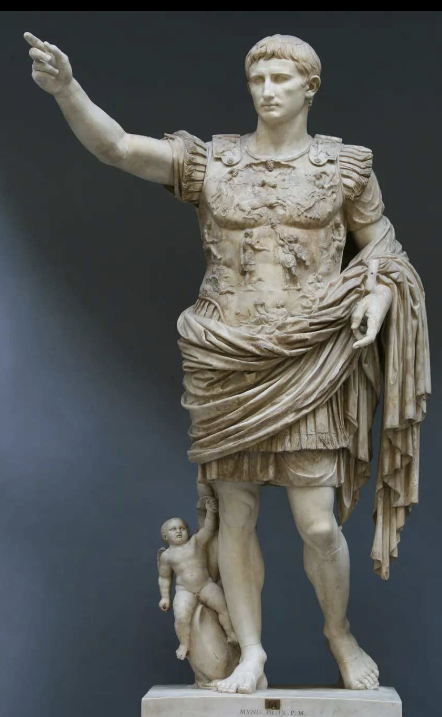
Augustus of Primaporta, perhaps a copy of a bronze statue of early 1st century BCE
portraits of emperors served as powerful forms of political propaganda
stoic, decisive
no wrinkles or aging
eternally youthful and strong
Augustus was actually older in real life but he is portrayed as young
pointing of finger to show ruling his people
toga and armour
shows his rise to power due to conquering of states and political appear
posture and classical standard stance
idealized body, perfect proportions
contrapposto
cupid by his leg
divine lineage
evokes Venus (goddess of love)
Augustus traced his family lineage to Venus
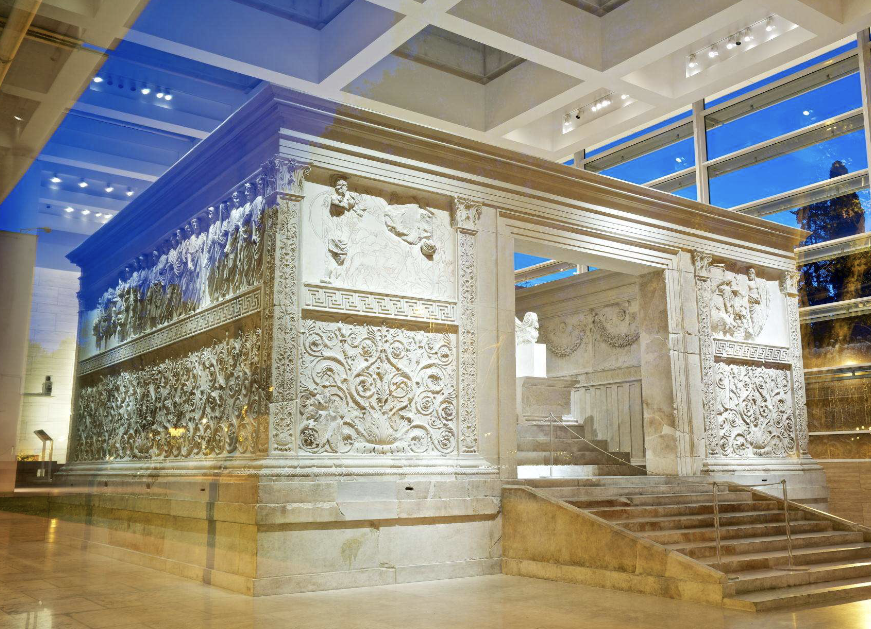
Ara Pacis Augustae, Rome, Italy, 13-9 BCE
Altar of peace
presented Augustus not only as a strong leader but someone chosen and supported by gods
dedicated to Pax Romana
functional altar where sacrifices were made and rituals to please the gods
he is the Pontifex Maximus (high priest of Roman religion)
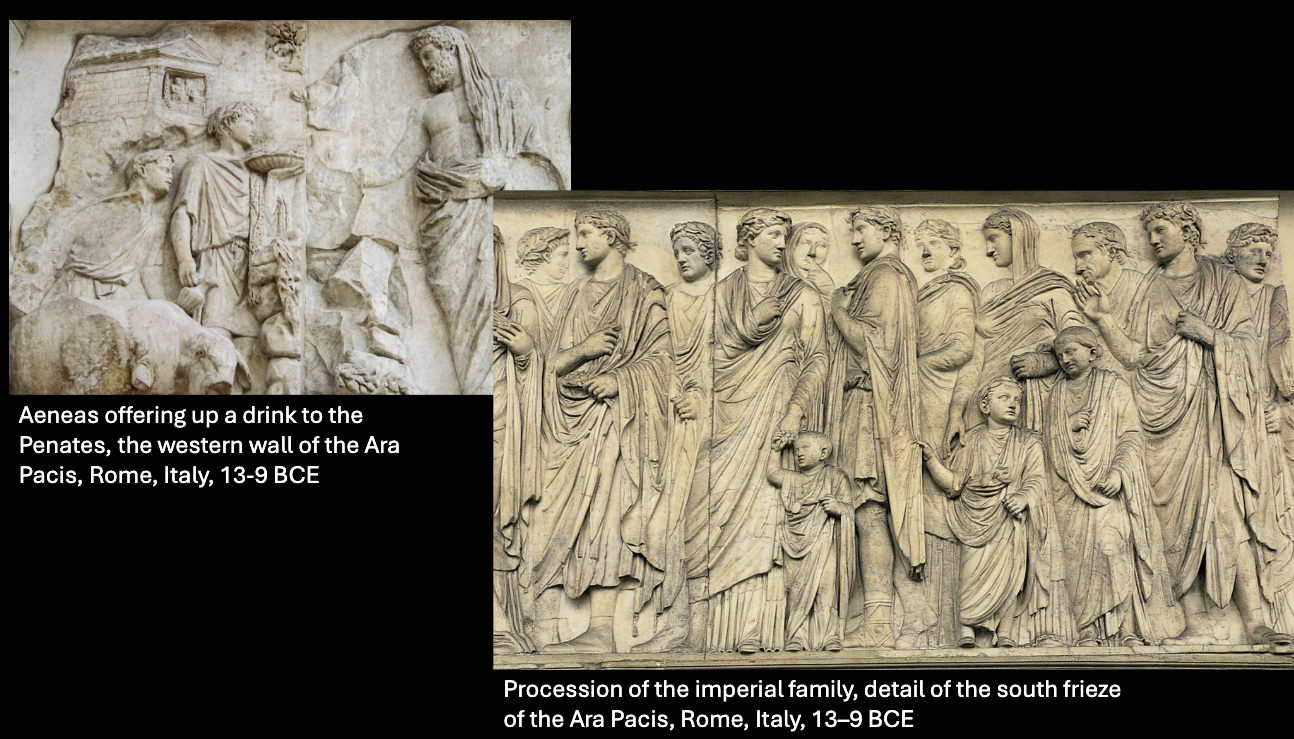
left = Aeneas offering up a drink to the Penates, Italy 13-9 BCE
Aeneas (son of Venus) making sacrifice
reinforces Venus lineage
right = procession of the imperial family, Italy 13-9 BCE
showcasing recognizable people (priests, children of foreign kings)
representation of children
showing a peaceful empire, foreign powers were in alliance with Rome
What occurs after the death of Augustus? What was their leader like?
Julio-Claudian dynasty
Nero as leader
chaotic, egotistical
took his life to avoid assassination
Who reigned after Nero?
Vespasian-Flavian dynasty
construction of the Colosseum
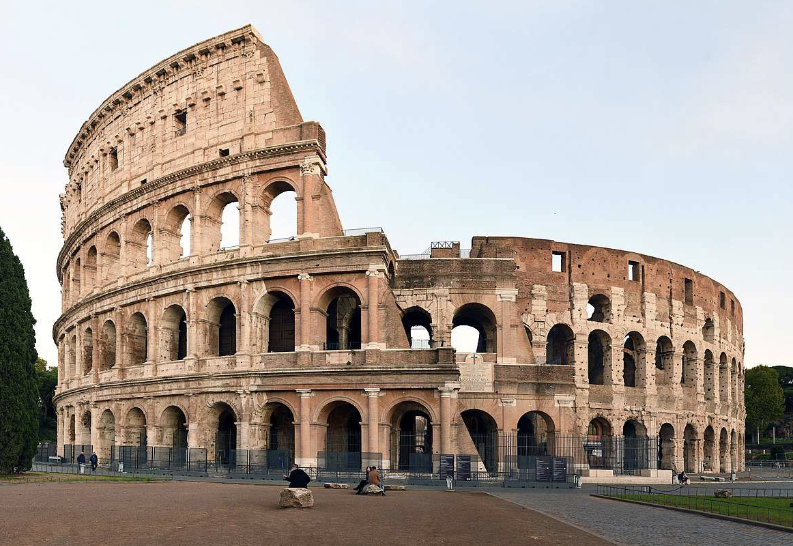
The Colosseum (Flavian Amphitheatre), Rome, Italy, 70-80 CE
highly political
choosing side of Nero’s private villa to build a public structure instead
reclaiming it
undoing Nero’s selfishness and flamboyant lifestyle
giving land back to Roman people
largest entertainment venue
area for gladiator and animal combats
lavish performances
By building the colosseum, what are the Flavian’s doing?
reasserting power of Flavian dynasty
restoring relationship with people
distracting the people to not stir any revolutions
What was the importance of concrete?
mixing chips of stone and sand with a binder (line and volcanic ash)
artificial stone that can be molded
durable, flexible, versatile
construction of complex vaulting system
arched structure
What is barrel vaulting?
continuous row of arches joined together
stackable
colosseum is stacked barrel vaults
What is the architecture of the Colosseum?
4 levels
entrances
arches are framed by pairs of columns
engaged columns
Roman columns were decorative not functional
they serve aesthetic purposes
arches and concrete are structural
columns evoke a link between Roman engineering and Greek orders
Romans admired Greek culture
What are the orders in the Colosseum?
doric orders on bottom, ionic in middle, Corinthian on top
hierarchy
sturdiest at bottom and decorative and delicate at top
What are Corinthian orders?
leaves and complex fluting
several decorative bands
When was the Eruption of Mount Vesuvius and what did it cause?
79 CE
destroyed the cities of Pompeii and Herculaneum
thousands of deaths
ashes preserved the paintings and buildings
also preserved the casts of bodies
seals them off from weathering and protects from looters
looters are people that strip buildings of precious materials
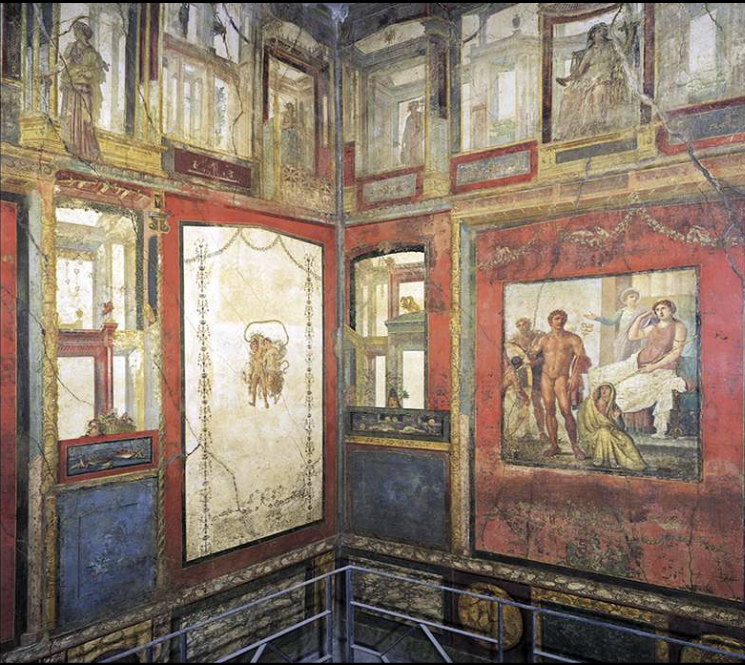
Fourth style painting, Ixion Room, House of Vettii, Pompeii, 1st c. CE
depicts typical Roman house
central courtyard (atrium) surrounded by colonnade
combination of illusionistic architectural elements (illusion of depth in wall art) with dense decorative details
complex compositions
visually extending the space of the villa
High Empire time
96-192 CE
Who followed Titus as roman emperor? What was he like?
Domitian followed
more like Nero
cruel, egotistical, authoritarian
he was assassinated
Senate tried to erase all evidence that he existed
face was erased, sculpture was muted
Damnatio Memoria
Which emperor followed Domitian?
Trajan
loved by the people
elected with consent of Senate
Roman empire reached greatest expanse
social programs, urban infrastructure
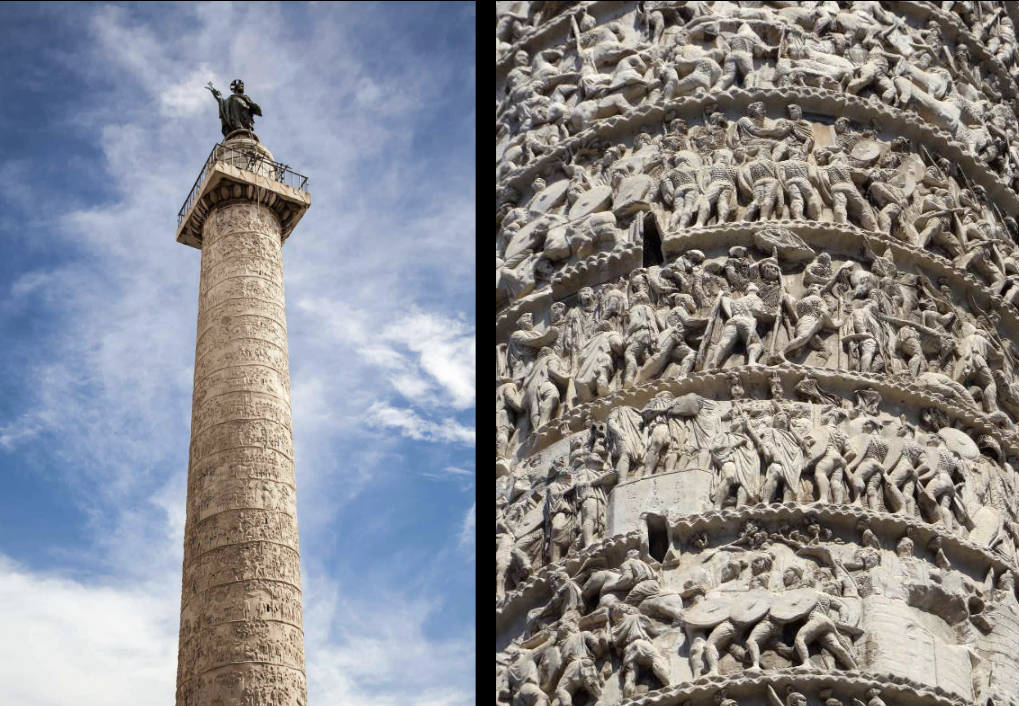
Don’t name but describe
monument to commemorate the defeat of Dacians
symbolic structure not functional
spiral relief goes around column
frieze that winds like comic strip
tells story of Trajan’s victory over Dacians
he was a practical leader
turtle shell of shields to protect
also showed Romans tending to the wounded
sense of realism
most scenes on column do not depict battle and instead show preparing, negotiation, routine business of warfare
this is how Trajan wanted to be seen (hands-on and personally directed and expanding Roman empire)
Who succeeded Trajan?
Hadrian
begins to work on Pantheon
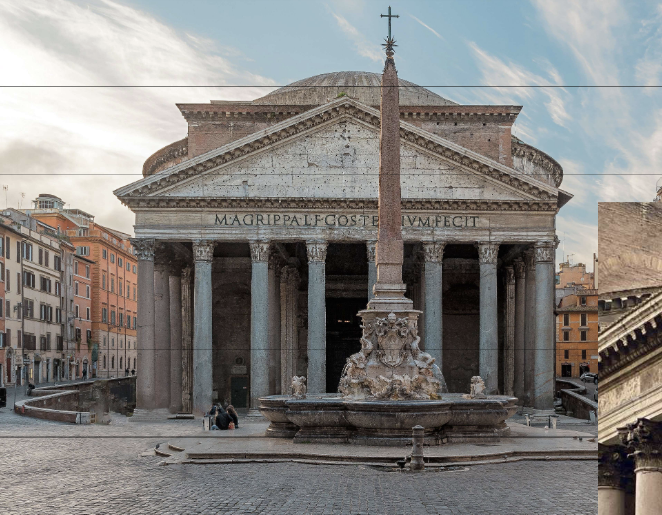
Apollodorus of Damascus, Pantheon, 113-125 CE
reveals full potential of concrete
facade
corinthian columns
triangular pediment sitting on top
very Greek-like temple
building behind is revolutionary
round in plan
Describe round dome behind Pantheon.
Rotunda
immense cylinder
Dome
Oculus
opening at the top at the apex
dramatic effect with light, cinematic effect
placing a hole at the most fragile point on the dome (where all tension lines converge)
Coffered ceiling
ceiling is divided into recessed panels, creating a grid-like pattern
What are the two main points in the Andrette reading?
Rome urban experiences were characterized by sensory overload
experiences were highly stratified by gender, class, social standing
What is an insula?
a city block or an apartment building
What were Roman baths? What were gardens?
public thermae
people would go bathe, gossip, socialize
provide shaded walkways
both provide a relief to the senses from the urban environment
women were not permitted in these spaces
How did Romans change Greek religion slightly?
Romans identified their own gods with those of the Greek
Zeus became Jupiter
Hera became Juno
Aphrodite became Venus
During prime Roman religion, what happened to Christians?
Christianity was at the beginning but Christians were persecuted
it challenged the Roman pantheon so it was threatening
these Christians refused to worship Roman gods
Late Empire time.
193-337 CE
What occurs during the Late Empire?
Roman empire begins moving away from pantheon of gods
under the rule of Constantine the Great
Battle of the Milvian Ridge
he embraced Christianity
What was the Edict of Milan?
313 AD
granted Christianity legal status
Christians were no longer persecuted and were instead protected by law
What did Constantine the Great build?
built first Christian churches
first major basilica
turned public building used for admin and law court into Christian churches
What was the structure of basilicas?
rectangular in shape
wide central nave (alleyway)
flanked by side aisles and a roof built on two levels
didn’t use temples since they were too closely related to the Gods
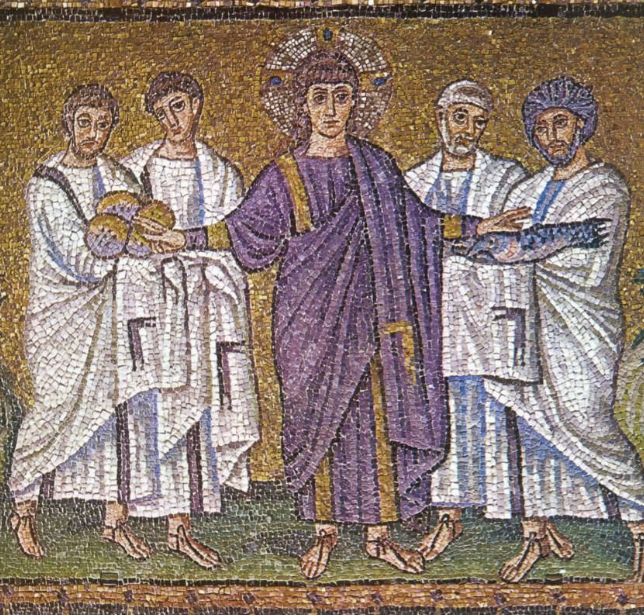
Name piece and describe mosaics?
Christ between Four Apostles (The Miracle of Loaves and Fishes), early 6th century mosaic, Sant’Apollinare Nuovo, Ravenna.
Jesus is larger and in centre with halo and crown
symmetrical and stiff pose with arms spread and face directly toward viewer
almost Archaic
wearing empirical colour (purple)
represented as young, powerful, triumphant
background tells us were in a divine realm
move away from illusionism and realism
it is not for the lack of skill, it is a choice to bring viewer into a spiritual reflection
mosaic is very durable and meant to survive the elements
the choice of the medium says ‘Christianity is here to stay’
Mosaics lined the altar and the naves
The Fall of Rome time. Who was the last Roman emperor?
476 AD
internal problems and constant political instability
external pressure on Rome
Roman empire falls
Romalis Augustus was the last emperor and forced to leave